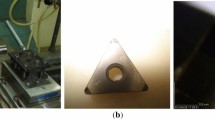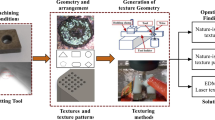Abstract
A new dry cutting tool named WS2 soft coated Micro-Nano textured self-lubricating dry cutting tool (WTT tool) is developed and tested. Dry turning tests have been carried out on 45# quenched and tempered steel with a WTT tool and three other types of alternative tools. The machining performance was assessed in terms of the cutting forces, cutting temperature, friction coefficient at the tool-chip interface, chip deformation, tool wear, and the surface roughness of the machined workpiece. The results show that the WTT tool has the best cutting performance among all the tools tested under the same cutting conditions. Through theoretical analysis and experimental results, the mechanisms of the WTT tool in improving cutting performance were put forward. Meanwhile, the effect of Micro-Nano texture and WS2 soft coating on the cutting forces and the cutting temperature is analyzed. It can be concluded that the WTT tool can effectively improve the anti-adhesion and wear-resistance properties and increase the tool life.
Similar content being viewed by others
References
Wiklund, U., Rubino, S., Kádas, K., Skorodumova, N. V., Eriksson, O., et al., “Experimental and Theoretical Studies on Stainless Steel Transfer onto a TiN-Coated Cutting Tool,” Acta Materialia, Vol. 59, No. 1, pp. 68–74, 2011.
Deng, J. X., Song, W. L., and Zhang, H., “Design, Fabrication and Properties of a Self-Lubricated Tool in Dry Cutting,” International Journal of Machine Tools and Manufacture, Vol. 49, No. 1, pp. 66–72, 2009.
Liu, Z. F., Zhang, C. G., and Ren, J. L., “Dry Machining Technology and Application,” China Machine Press, 2005.
Faga, M. G., Priarone, P. C., Robiglio, M., Settineri, L., and Tebaldo, V., “Technological and Sustainsaility Implications of Dry, Near-Dry, and Wet Turning of Ti-6Al-4V Alloy,” Int. J. Precis. Eng. Manuf.-Green Tech., Vol. 4, No. 2, pp. 129–139, 2017.
Zhao, J., Ai, X., and Lu, Z. J., “Preparation and Characterizaion of Si3N4/TiC Nanocomposite Ceramics,” Materials Letters, Vol. 60, No. 23, pp. 2810–2813, 2006.
Loginov, P., Jr, L. M., Levashov, E.. and Petrzhik, M., “Diamond and CBN Hybrid and Nanomodified Cutting Tools with Enhanced Performance: Development, Testing and Modelling,” Materials & Design, Vol. 88, pp. 310–319, 2015.
Dureja, J. S., Singh, R., Singh, T., Singh, P., Dogra, M., et al., “Performance Evaluation of Coated Carbide Tool in Machining of Stainless Steel (AISI 202) under Minimum Quantity Lubrication (MQL),” Int. J. Precis. Eng. Manuf.-Green Tech., Vol. 2, No. 2, pp. 123–129, 2015.
Michailidis, M., “Variations in the Cutting Performance of PVDCoated Tools in Milling Ti6Al4V, Explained Through Temperature-Dependent Coating Properties,” Surface and Coatings Technology, Vol. 304, pp. 325–329, 2016.
Broniszewski, K., Wozniak, J., Kostecki, M., Czechowski, K., Jaworska, L., et al., “Al2O3-V Cutting Tools for Machining Hardened Stainless Steel,” Ceramics International, Vol. 41, No. 10, pp. 14190–14196, 2015.
Deng, J. X., Cao, T. K., and Yang, X. F., “Self Lubrication of Sintered Ceramic Tools with CaF2 Additions in Dry Cutting,” International Journal of Machine Tools and Manufacture, Vol. 46, No. 9, pp. 957–963, 2006.
Olofinjana, B., Martin, C. L., Ajayi, O. O., and Ajayi, E. O., “Effect of Laser Surface Texturing (LST) on Tribochemical Films Dynamics and Friction and Wear Performance,” Wear, Vol. 332-333, pp. 1225–1230, 2015.
Chen, P., Xiang, X., Shao, T., La, Y., and Li, J., “Effect of Triangular Texture on the Tribological Performance of Die Steel with TiN Coatings under Lubricated Sliding Condition,” Applied Surface Science, Vol. 389, pp. 361–368, 2016.
Li, J., He, Y., Xiong, D., Qin, Y., Chen, J., et al., “Tribological Properties of Silver Coatings with Laser Surface Textured Nickel as Interlayer,” Tribology International, Vol. 100, pp. 178–185, 2016.
Xu, Y., Peng, Y., Dearn, K. D., You, T., Geng, J., et al., “Fabrication and Tribological Characterization of Laser Textured Boron Cast Iron Surfaces,” Surface and Coatings Technology, Vol. 313, pp. 391–401, 2017.
Kovalchenko, A., Ajayi, O., Erdemir, A., and Fenske, G., “Friction and Wear Behavior of Laser Textured Surface Under Lubricated Initial Point Contact,” Wear, Vol. 271, Nos. 9-10, pp. 1719–1725, 2011.
Lei, S., Devarajan, S., and Chang, Z. H., “A Study of Micropool Lubricated Cutting Tool in Machining of Mild Steel,” Journal of Materials Processing Technology, Vol. 209, No. 3, pp. 1612–1620, 2009.
Sharma, V. and Pandey, P. M., “Recent Advances in Turning with Textured Cutting Tools: A Review,” Journal of Cleaner Production, Vol. 137, pp. 701–715, 2016.
Sugihara, T. and Enomoto, T., “Development of A Cutting Tool with A Nano/Micro-Textured Surface-Improvement of Anti-Adhesive Effect by Considering the Texture Patterns,” Precision Engineering, Vol. 33, No. 4, pp. 425–429, 2009.
Arulkirubakaran, D., Senthilkumar, V., and Kumawat, V., “Effect of Micro-Textured Tools on Machining of Ti-6Al-4V Alloy: An Experimental and Numerical Approach,” International Journal of Refractory Metals and Hard Materials, Vol. 54, pp. 165–177, 2016.
Koshy, P. and Tovey, J., “Performance of Electrical Discharge Textured Cutting Tools,” CIRP Annals-Manufacturing Technology, Vol. 60, No. 1, pp. 153–156, 2011.
Deng, J. X., Wu, Z., Lian, Y. S., Qi, T., and Cheng, J., “Performance of Carbide Tools with Textured Rake-Face Filled with Solid Lubricants in Dry Cutting Processes,” International Journal of Refractory Metals and Hard Materials, Vol. 30, No. 1, pp. 164–172, 2012.
Hao, R., Tedstone, A. A., Lewis, D. J., Warrens, C. P., West, K. R., et al., “Property Self-Optimization during Wear of MoS2,” ACS Applied Materials & Interfaces, Vol. 9, No. 2, pp. 1953–1958, 2017.
Cao, X., Shi, Y., Shi, W., Rui, X., Yan, Q., et al., “Preparation of MoS2-Coated Three-Dimensional Graphene Networks for High-Performance Anode Material in Lithium-Ion Batteries,” Small, Vol. 9, No. 20, pp. 3433–3438, 2013.
Zhang, X., Vitchev, R. G., Lauwerens, W., Stals, L., He, J., et al., “Effect of Crystallographic Orientation on Fretting Wear Behaviour of MoSx Coatings in Dry and Humid Air,” Thin Solid Films, Vol. 396, Nos. 1-2, pp. 69–77, 2001.
Scharf, T. W., Prasad, S. V., Dugger, M. T., Kotula, P. G., Goeke, R. S., et al., “Growth, Structure, and Tribological Behavior of Atomic Layer-Deposited Tungsten Disulphide Solid Lubricant Coatings with Applications to MEMS,” Acta Materialia., Vol. 54, No. 18, pp. 4731–4743, 2006.
Wang, D., Hu, M., Jiang, D., Gao, X., Fu, Y., et al., “Preparation and Characterization of the CrN Nanocone Array Textured WS2 Film,” Materials Letters, Vol. 188, pp. 267–270, 2017.
Zheng, X. H., Tu, J. P., Lai, D. M., Peng, S. M., Gu, B. et al., “Microstructure and Tribological Behavior of WS2-Ag Composite Films Deposited by RF Magnetron Sputtering,” Thin Solid Films, Vol. 516, No. 16, pp. 5404–5408, 2008.
Zhu, L. N., Wang, C. B., Wang, H. D., Xu, B. S., Zhuang, D. M., et al., “Tribological Properties of WS2 Composite Film Prepared by A Two-Step Method,” Vacuum, Vol. 85, No. 1, pp. 16–21, 2010.
Aldana, P. U., Dassenoy, F., Vacher, B., Mogne, T. L., and Thiebaut, B., “WS2 Nanoparticles Anti-Wear and Friction Reducing Properties on Rough Surfaces in the Presence of ZDDP Additive,” Tribology International, Vol. 102, pp. 213–221, 2016.
Wang, A. H., Zhang, X. L., Zhang, X. F., Qiao, X. Y., Xu, H. G., et al., “Ni-Based Alloy/Submicron WS2 Self-Lubricating Composite Coating Synthesized by Nd:YAG Laser Cladding,” Materials Science and Engineering: A, Vol. 475, Nos. 1-2, pp. 312–318, 2008.
Chen, R. Y., “Principle of Metal Cutting,” China Machine Press, 1992.
Loewen, E. and Shaw, M., “On the Analysis of Cutting Tool Temperatures,” Trans. ASME, Vol. 76, pp. 217–225, 1954.
Author information
Authors and Affiliations
Corresponding author
Rights and permissions
About this article
Cite this article
Lian, Y., Chen, H., Mu, C. et al. Experimental Investigation and Mechanism Analysis of Tungsten Disulfide Soft Coated Micro-Nano Textured Self-Lubricating Dry Cutting Tools. Int. J. of Precis. Eng. and Manuf.-Green Tech. 5, 219–230 (2018). https://doi.org/10.1007/s40684-018-0022-9
Received:
Revised:
Accepted:
Published:
Issue Date:
DOI: https://doi.org/10.1007/s40684-018-0022-9




